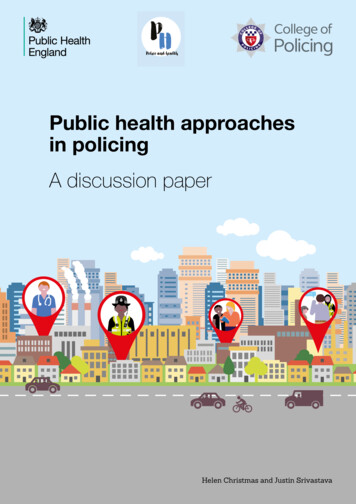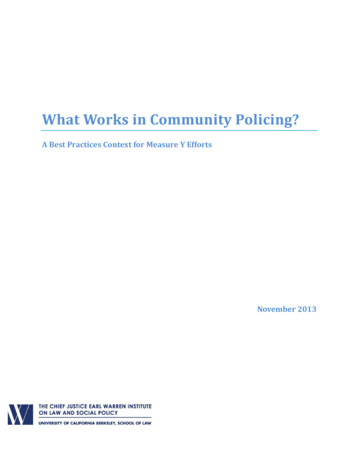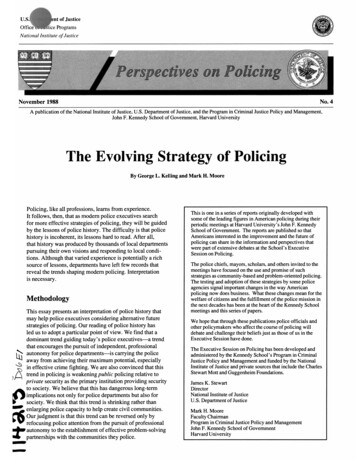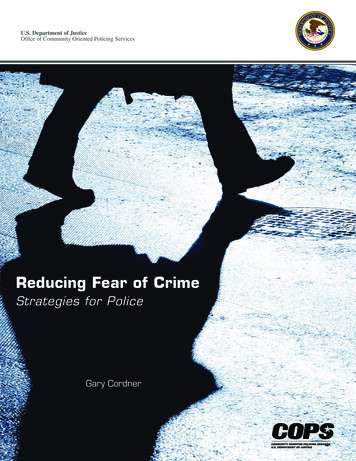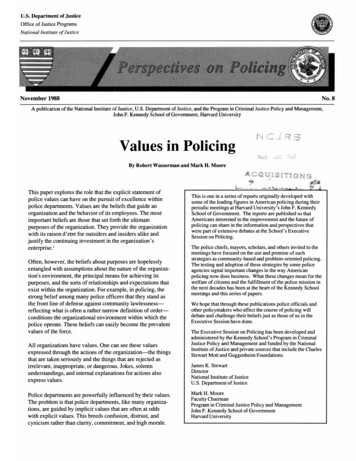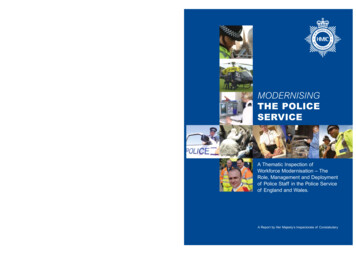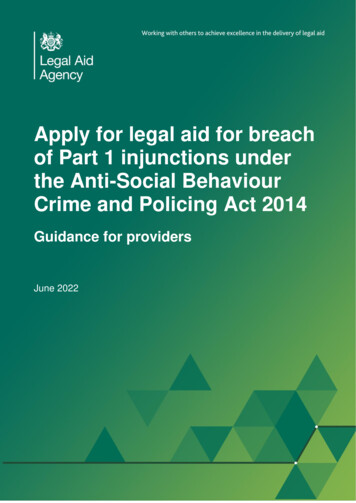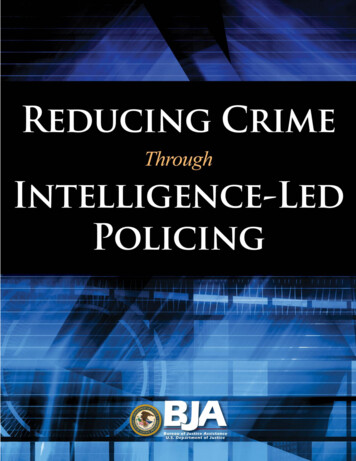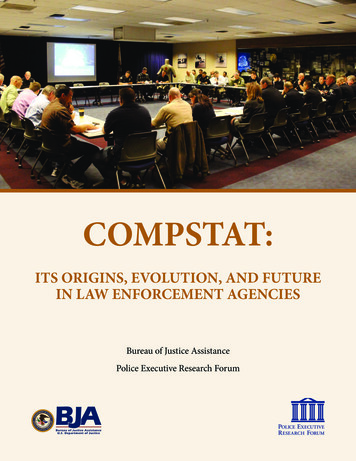
Transcription
U.S. Department of JusticeNational Institute of JusticeNo. 2June 1988.A publication of the National Institute of Justice, U.S. Department of Justice, and the Program in Criminal Justice Policy and Management,John F. Kennedy School of Government, Harvard UniversityCrime and PolicingBy Mark H. Moore, Robert C. Trojanowicz, and George L. KellingThe core mission of the police is to control crime. No onedisputes this. Indeed, professional crime fighting enjoys widepublic support as the basic strategy of policing precisely because it embodies a deep commitment to this objective. Incontrast, other proposed strategies such as problem-solvingor community policing appear on the surface to blur thisfocus.' If these strategies were to leave the community morevulnerable to criminal victimization,they would be undesirable alternatives. In judging the value of alternativepolicestrategies in controllingcrime, however, one should not bemisled by rhetoric or mere expressed commitment to thegoal; one must keep one's eye on demonstrated effectivenessin achieving the goal.Professional crime-fighting now relies predominantly onthree tactics: (1) motorized patrol; (2) rapid response to callsfor service; and (3) retrospectiveinvestigationof crime . Over the past few decades,police responsiveness has beenenhanced by connectingpolice to citizens by telephones,radios, and cars, and by matching police officer schedulesand locations to anticipated calls for s e i c eThe. policefocus on serious crime has also been sharpened by screeningcalls for service, targeting patrol, and developing forensictechnology (e.g., automated fingerprint systems, computerized criminal record files, e t . ) . Although these tactics have scored their successes, they havebeen criticized within and outside policing for being reactiverather than proactive. Ttiey have also been criticized forfailing to prevent crime.5Reactive tactics have some virtues, of course. The police gowhere crimes have occurred and when citizens have summoned them; otherwise, they do not intrude. The police keeptheir distance from the community, and thereby retain theirimpartiality.They do not develop the sorts of relationshipswith citizens that could bias their responses to crime incidents. These are virtues insofar as they protect citizens froman overly intrusive, too familiarpolice.This is one in a series of reports originally developed with someof the leading figures in American policing during theirperiodic meetings at Harvard University's John F. KennedySchool of Government. The reports are published so thatAmericans interested in the improvement and the future ofpolicing can share in the information and perspectives that werepart of extensive debates at the School's Executive Session onPolicing.The police chiefs, mayors, scholars, and others invited to themeetings have focused on the use and promise of suchstrategies as community-based and problem-oriented policing.The testing and adoption of these strategies by some policeagencies signal important changes in the way Americanpolicing now does business. What these changes mean for thewelfare of citizens and the fulfillmentof the police mission inthe next decades has been at the heart of the Kennedy Schoolmeetings and this series of papers.We hope that through these publications police officials andother policymakers who affect the course of policing willdebate and challengetheir beliefsjust as those of us in theExecutive Sessionhave done.The Executive Session on Policing has been developed andadministeredby the Kennedy School's Program in CriminalJustice Policy and Management and funded by the NationalInstitute of Justice and private sources that include the CharlesStewart Mott and Guggenheim Foundations.James K. StewartDirectorNational Institute of JusticeU.S. Department of JusticeMark H. MooreFaculty ChairmanProgram in Criminal Justice Policy and ManagementJohn F. Kennedy School of GovernmentHarvard University
Moreover, the reactive tactics do have preventive effects-atleast in theory. The prospect of the police arriving at a crimein progress as a result of a call or a chance observation isthought to deter rirnes. The successful prosecution ofoffenders (made possible by retrospective investigation) isalso thought to deter offenders?And even if it does not deter,a successfully prosecuted investigation incapacitates criminals who might otherwise go on to commit other rimes. 44 Reactive tactics do have preventive effectsat least in theory . 9 9.-Finally, many police forces have developed proactive tacticsto deal with crime problems that could not be handledthrough conventional reactive methods. In drug dealing,organized crime, and vice enforcement, for example, whereno immediatqvictims exist to mobilize the police, the policehave develop6d special units which rely on informants,covert surveillance,and undercover investigations ratherthan responses to calls for service? In the area of juvenileoffenses where society's stake in preventing crimes seemsparticularly great, the police have created athletic leagues,formed partnerships with schools to deal with drug abuse andtruancy, and so on.1 It is not strictly accurate, then, tocharacterize modem policing as entirely reactive.Still, the criticism of the police as being too reactive hassome force. It is possible that the police could do more tocontrol serious crime than they now achieve. Perhapsresearch will yield technological breakthroughs that willdramatically improve the productivity of police investigation. For now, however, the greatest potential for improvedcrime control may not lie in the continued enhancement ofresponse times, patrol tactics, and investigative techniques.Rather, improved crime control can be achieved by (1)diagnosing and managing problems in the community thatproduce serious crimes; (2) fostering closer relations with thecommunity to facilitate crime solving; and (3) building selfdefense capabilities within the community itself. Among theresults may be increased apprehension of criminals. To theextent that problem-solving or community strategies ofpolicing direct attention to and prepare the police to exploitlocal knowledge and capacity to control crime, they will beuseful to the future of policing. To explore these possibilities, this paper examines what is known about serious crime:what it is, where and how it occurs, and natural points ofintervention. Current and proposed police tactics are thenexamined in light of what is known about their effectivenessin fighting serious crime.Serious crimeTo individual citizens, a serious crime is an offense that happened to them. That is why police departments throughoutthe country are burdened with calls requesting responses tooffenses that the police regard as minor. While there arereasons to take such calls seriously, there is also the socialand administrative necessity to weigh the relative gravity ofthe offenses. Otherwise, there is no principle for apportioning society's indignation and determination to punish; nor isthere any basis for rationing police responses. The concept ofserious crime, then, is necessarily a social judgment-not anindividual one. Moreover, it is a value judgment-not simplya technical issue. The question of what constitutes seriouscrime is resolved formally by the criminal code. But thecriminal code often fails to give precise guidance to policeadministrators who must decide which crimes to emphasize.They need some concept that distinguishes the offenses thatproperly outrage the citizenry and require extended policeattention from the many lesser offenses that pose less urgentthreats to society.Like many things that require social value judgments, theissue of what constitutes serious crime is badly neglected."Rather than face a confusing public debate, society relies onconvention, or administrative expertise, or some combinationof the two, to set standards. Yet, if we are to assess andimprove police practice in dealing with serious crime, it isnecessary to devote some thought to the question of whatconstitutes serious crime.66 To individual citizens, a serious crime is anoffense that happened to them. That is whypolice departments. are burdened with callsrequesting responses to offenses that the policeregard as minor. 9 9.Defining serious crimeThe usual view of serious crime emphasizes three characteristics of offenses. The most important is physical violence orviolation. Death, bloody wounds, crippling injuries, evencuts and bruises increase the severity of a crime.12Sexualviolation also has a special urgency.13 Crime victims oftensuffer property losses as well as pain and violation. Economic losses count in reckoning the seriousness of anoffense. Still, society generally considers physical attackssexual and nonsexual-as far more serious than attacks onproperty.14A second feature of serious crime concerns the size of thevictim's losses. A robbery resulting in a murder or a permanent, disfiguring injury is considered worse than one thatproduces only cuts, bruises, and fears. An armored car heistnetting millions is considered more serious than a pursesnatching yielding the price of a junkie's next fix.Third, the perceived seriousness of an offense is influencedby the relationship between offenders and victims. Commonly, crimes against strangers are viewed as more seriousthan crimes committed in the context of ongoing relationships.15The reason is partly that the threat to society fromindiscriminate predators is more far-reaching than the threat
from offenders who limit their targets to spouses, lovers, andfriends. Moreover, society judges the evil intent of the offender to be more evident in crimes against strangers. Inthese crimes, there are no chronic grievances or provocationsin the background to raise the issue of who attacked whomfirst and in what way. The crime is an out-and-out attack, nota mere dispute.16These characteristics-violence, significant losses to victims,predatory strangers-capturemuch of what is important tosocietal and police images of serious crime. The intuitiveappeal of these criteria is reflected in the categories of theFBI's Uniform Crime Reports. Murder, rape, robbery,burglary, aggravated assault, and auto theft (most presumably committed by strangers) are prominently reported as PartI Offenses. This key, national account of crime not onlyreflects, but anchors society's view of serious crime aspredatory street crime.66 Society judges the evil intent of the offenderto be more evident in crimes against strangers. 19cal fact that minor offenses and incivilities trigger citizens'fears more than actual crime victimization. Rowdy youth,abandoned cars, and m i t i frighten people, force them torestrict their movements, and motivate them to buy guns,locks and dogs. To the extent that the conventional view ofserious crime deflects attention from fear and the offensesthat stimulate fear, it may obscure an important opportunityfor the police to contribute to the solution of the seriouscrime problem.Third, defining serious crime in terms of the absolute magnitude of material losses to victims (without referbnce to thevictim's capacity to absorb the loss, or the implications ofthe losses for people other than the victim) introduces thepotential for injustice and ineffectiveness in targeting policeattention. In the conventional view, a jewel theft at a swankhotel attracts more attention than the mugging of an elderlywoman for her Social Security check. Yet it is clear that thestolen Social Security check represents a larger portion of theelderly woman's wealth than the losses to the hotel's wellinsured customers. The robbery of a federally byzed bankwould attract more attention than the robbery of an inner-cityconvenience store. But the robbery of the ghetto store couldend the entrepreneurial career of the owner, drive the storefrom the area, and, with the store's departure, deprive theneighborhood of one of its few social underpinnings.While this notion has the sanction of intuitive appeal, convention, and measurement, it also contains subtle biaseswhich, once pointed out, might cause society and the policeto adjust their traditional views. First, the accepted image ofcrime seems to downplay the importance of crime committedin the context of ongoing relationships. From the perspectiveof the general citizenry, such offenses seem less importantbecause they do not pose a general threat to society. Fromthe perspective of the police (and other criminal justiceofficials), such crimes are less clear-cut because the existence of the prior relationship muddies the distinctionbetween offender and victim and increases the likelihood thata case will be dropped when the antagonists resolve thedispute that produced the offense.Fourth, to the extent that the conventional view of crimeemphasizes the reality of individual criminal victimization, itunderplays crimes that have symbolic significance. Thecurrent emphasis on child sexual abuse, for example, isimportant in part because it sustains a broad social commitment to the general care and protection of children. Thecurrent emphasis on domestic assault, among other things,helps to sustain a normative movement that is changing thestatus of women in marriages. The interest in white-collareconomic crimes and political corruption can be explainedby the desire to set higher standards for the conduct of thosein powerful positions. The social response to these offensesis important because it strengthens, or redefines, broad socialnorms.From the victim's point of view, however, the fact of a relationship to the offender dramatically intensifies the seriousness of the offense. A special terror arises when one islocked into an abusive relationship with a spouse or lover. Adate that turns into a rape poisons a victim's psyche muchmore than an attack by a stranger. And, as Boston PoliceCommissioner Mickey Roache found when he was heading aunit dealing with interracial violence in Boston, seriousinterracial intimidation and violence did not appear in crimereports as robberies or burglaries. Rather, the serious crimesappeared as vandalism. What made the vandalism terrifyingwas that it was directed at the same address night after night.66 The view of crime as predatorymisses theterror of the abused spouse or molested child,the wide social consequences of driving merchants out of business, the rot that drug dealing,and the polarizing effects of fear. 99bringsSecond, the view of serious crime as predatory violencetends to obscure the importance of fear as a separate,pernicious aspect of the crime problem. To a degree, theissue of fear is incorporated in the conventional view ofserious crime. Indeed, fear is what elevates predatory streetcrimes above crimes that occur within personal relationships.What the conventional view misses, however, is the empiri-.In sum, the view of crime as predatory, economically significant violence stresses the substantial losses associated withstreet offenses. It obscures the losses to society that resultfrom offenses that poison relationships, transform neighborhoods into isolated camps, and undermine important socialinstitutions. It misses the terror of the abused spouse or
molested child, the wide social consequences of driving merchants out of business, the rot that drug dealing brings to anurban community, and the polarizing effects of fear.An alternative view of serious crime would be one that acknowledged violence as a key component of serious crimebut added the issues of safety within relationships, theimportance of fear, and the extent to which offenses collapseindividual lives and social institutions as well as inflictindividual losses. This enlarged conception rests on theassumption that the police can and should defend more socialterrain than the streets. Their challenge is to preserve justiceand order within the institutions of the community.Levels, trends, and social location of serious crimeIt is no simple matter to represent the current levels, recenttrends, and social location of serious crime. Still, severalimportant observations can be made.First, in any year, a noticeable fraction of American households is touched by serious crime. In 1986,5 percent ofAmerican households experienced the violence associatedwith a rape, robbery, or assault. Almost 8 percent of households were touched by at least one serious crime: rape,robbery, aggravated assault, or burglary.'' When consideringthe likelihood that a household will be victimized sometimein the next 5 years, these figures increase dramatically, for ahousehold faces these risks each year. Thus, most Americanhouseholds have first- or second-hand experience withserious crime.Second, from the mid-1960's to the mid-1970's, the UnitedStates experienced a dramatic increase in the level of seriouscrime. In fact, the level of serious crime reached historichighs. Since the mid-seventies, the level of serious crime hasremained approximately constant, or declined slightly.18C C Criminal victimization is disproportionatelyconcentrated among minority and poor populations in the United States. 99Third, criminal victimization is disproportionately concentrated among minority and poor populations in the UnitedStates. Homicide is the leading cause of death for youngminority males living in metropolitan areas?gBlack households are victimized by violent crimes such as robbery, rape,and aggravated assault at one and a half times the frequencyof white families. The poor are victimized at one and a halftimes the rate of the wealthy." These numbers probablyunderestimate the real differences in the losses- materialand psychological--experienced by rich and poor victims,since those who are black and poor have fewer resources todeal with the losses associated with victimization.Precipitating causes of serious crimeIn searching for ways to prevent or control serious crime, thepolice look for precipitating causes. While it may be usefulto examine what some call the root causes of crime (e.g.,social injustice, unequal economic opportunity, poorschooling, weak family structures, or mental illness), suchthings are relatively unimportant from a police perspectivesince the plice exercise little influence over them.21Thepolice operate on the surface of social life. They must handleincidents, situations, and people as they are now-notsocieties or people as they might have been. For thesereasons, the immediately precipitating causes of seriouscrime are far more important to the police than are broaderquestions about the root causes of crime. Four precipitatingcauses of crime seem relevant to policing: (1) dangerouspeople; (2) criminogenic situations; (3) alcohol and drug use;and (4) frustrating relationships.CC The policemust handle incidents, situations, andpeople as they are now - notsocieties or people as they might have been. 9 9One way the police view serious crime is to see the precipitating cause in the character of the offender. A crime occurswhen a predatory offender finds a victim. One could reducesuch events by &ching potential victims to avoid situationsand behaviors that make them vulnerable. And, to somedegree, the police do this. But the far more common and attractive path for controlling predatory crime is to identifyand apprehend the predators. Thus, dangerous offenders canbe seen as a precipitating cause of serious crime and animportant focus of police attention."Recent research on criminal careers provides a firm empirical basis for this view.P Interviews with convicted criminalsconducted by the Rand Corporation indicate that somecriminal offenders committed crimes very frequently andsustained this activity over a long career." Moreover, theseviolent predators accounted for a substantial amount of theseriousNow, an investigation of the root causes ofsuch patterns of offending might disclose strong influencesof social disadvantage and psychological maltreatment inshaping the personalities of such offenders. Moreover, theinfluence of these factors might reasonably mitigate theirguilt. One might also hold out some hope for their futurerehabilitation (through the natural process of aging if nothingelse). So, the criminal proclivities of violent predators neednot be viewed as either inevitable or unchangeable. From thevantage point of the police, however, the presence of suchoffenders in the community can reasonably be viewed as animportant precipitating cause of crime. Controlling suchoffenders through incapacitation or close surveillance thusbecomes an important crime control strategy.Having noted the role of dangerous offenders in producingserious crime, it is worth emphasizing that such offenders-
account for only a portion of the total amount of seriouscrime-far more than their share, but still only about half ofall serious crime. The necessary conclusion is that asignificant portion of the serious crime problem cannot beattributed to determined attacks by career criminals or topredatory offenders. These crimes arise from quite differentcauses.Some of these crimes might be prduced by situationaleffects. Darkness and congestion around a subway exit maycreate an attractive location for muggings. An after-hours barmay host more than its share of fights. A rock house fromwhich crack is being sold may become a magnet for violence. Closing time in a popular disco may produce fightsamong teenagers leaving the scene. In sum, there are someplaces, times, and activities that bring people together inways that increase the likelihood of serious crime.The fact that this occurs is knowable to police. By analyzingcalls for service, they can observe that there are repeatedcalls made from certain places and at certain times.n These"hot spots" become important targets of police attention.%For example, patrol units might be dispatched just to sit andobserve at the appropriate times. There may also be othersolutions including permanent changes in the criminogenicsituations. For example, the subway area could be lighted;the attention of a neighborhood watch group could bedirected to the troublespot; the after-hours bar could be putout of business; aggressive street-level enforcement could bedirected against the rock house; or transportation could bearranged for the kids leaving the disco so the crowd thins outmore quickly.29Crimes are also significantly related to alcohol or drugab se.3 It is now quite clear that: (1)a surprisingly highpercentage of those arrested for serious crimes are drug oralcohol users;31(2) many offenders have drunk alcohol ortaken drugs prior to committing crimes;32and (3) victims aswell as offenders are often intoxicated or under the influenceof dr gs.3 What is unclear is exactly how alcohol and drugsproduce their criminogenic effect. Four hypotheses havebeen advanced to explain this phenomenon."44 Intoxicated people make particularly goodvictims. 99The first is that physiological effects stimulate or license theperson to commit crimes. The theory of stimulation may beappropriate to methamphetarnines or PCP, which sometimesseem to produce violent reactions among consumers. Thetheory of licensing or disinhibition seems more appropriatein the case of alcohol where the release of inhibitions isarguably the mechanism that permits offenses to occur.35Second, dependence or addiction forces users to spend moremoney on purchasing drugs, and they turn to crime in adesperate effort to maintain their habits. This is a powerfultheory in the case of heroin (under conditions of prohibition),and perhaps for cocaine. It is far less powerful for alcohol ormarijuana.Third, drug use gradually demoralizes people by puttingthem on the wrong side of the law, bringing them intocontact with criminals, and gradually weakening theircommitment to the obligations of a civil society. Again, thisseems more appropriate for those who become deeplyinvolved with drugs and alcohol over a long period of time,and therefore relies more on the dependence-producingattributes of drugs rather than on the immediate intoxicatingeffects.Fourth, intoxicated people make particularly good victims. Insome cases, intoxication makes people vulnerable to victimiati ion. In other cases, it causes victims to provoke their attacker . 'In either case, a serious crime can result.Whichever theory, or theories, is Correct, the close association among drugs, alcohol, and serious crime suggests thatthe amount of serious crime might be decreased by reducinglevels of alcohol and drug use, or by identifying thoseoffenders who use dhgs intensively and reducing theircons mption. -66 Many serious crimes including murders,robberies, rapes, and burglaries -are disputesand grievances among people rather thancriminal attacks. 9 9Finally, the fact that many serious offenses occur in thecontext of ongoing relationships suggests that some relationships may be criminogenic. Relationships can cause crimebecause they create expectations. If the expectations are notmet, the resulting disappointmentproduces anger. Anger maylead to vengeance and retaliation. In such cycles, the questionof who caused the ultimate crime becomes confused.Usually, the offender is the one least damaged after the fight.A court may conclude that the crime stemmed from the evilintentions of the person identified as the offender. But thismay not be the best way to view the problem from thevantage point of crime control or crime prevention.It might be more suitable to see the crimes as emerging froma set of relationships that are frustrating and provocative. Theproper response might be to work on the relationship throughmediation, restructuring, or dissolution. Indeed, this is oftenthe challenge confronting the police when they encounterspouse abuse, child abuse, and other sorts of intrafamilyviolence. In such situations, arrests may be appmpriate andeffective in detemng future crime and in restructuring therelati nship. There are many other crimes which emergefrom less obvious relationships: the personal relationships of
neighbors and friends; the economic relations of landlord andtenant or employer and employee; or transient relations thatlast just long enough to provoke a quarrel or seed a grudge.Seen this way, many serious crimes-including murders,robberies, rapes, and burglaries-are disputes and grievancesamong people rather than criminal attacks.It is important to understand that these weaknesses appearedin precisely those areas of crime control where the reactivestrategy should have been particularly strong: i.e., in dealingwith crimes such as murder, rape, robbery, assault, andburglary. These crimes could be expected to produce alarms;they also were interceptable and solvable by a vigilant policeforce waiting to be mobilized by outraged citizens.Controlling serious crimeThere are, of course, many other kinds of serious crimes forwhich the reactive police strategy is much more obviouslyinappropriate." It cannot, for example, deal with consensualcrimes such as drug dealing behind closed doors. Nor can itdeal with crimes such as extortion and loan sharking wherethe victims are too afraid to report the crimes. A reactivestrategy cannot deal with sophisticatedwhite collar crimes orpolitical corruption where the losses associated with thecrimes are so widely distributed that people do not noticethat they have been victimized. Finally, a reactive strategycannot deal even with traditional street crimes in those partsof cities where confidence in the police has eroded to such adegree that the citizens no longer call when they are victimized.Currently the police fight serious crime by developing a capacity to intercept it-to be in the right place at the righttime so that the crime is thwarted, or to arrive so quicklyafter the fact that the offender is caught. Reactive crimefighting is intuitively appealing to both the police and thoseto whom the police are accountable. It is unclear, however,whether the reactive response really works. Over the last twodecades, confidence in the reactive approach has been erodedby the accumulation of empirical evidence suggesting thatthese tactics are of only limited effectiveness. It is not thatthe approach fails to control crime. (It would be foolish toimagine that levels of serious crime would stay the same ifpolice patrols and investigations were halted.) Rather, thelimits of the reactive strategy are now becoming apparent.Further gains in police effectivenessin dealing with seriouscrime must come from different approaches. Key researchfindings suggesting the limitations of the reactive approachare these.First, the Kansas City Preventive Patrol Study found thatlevels of serious crime were not significantly influenced bydoubling the number of cars patrolling the streets.q0This castdoubt on the potential for reducing serious crime simply byincreasing the level of preventive patrol.Second, a study of the effectivenessof rapid response to callsfor service (also in Kansas City) found that the probability ofmaking an m s t for most serious crimes was unaffected bythe speed with which the police responded. The crucial factorwas not the speed of the police response, but the speed withwhich citizens raised the alarm. If citizens did not notice thecrime, or did not call the police quickly, no amount of speedin the police response helped muchP14 4 Confronted by high levels of crime andlimited budgets, the police felt a growing need forinitiative and thoughtfulness in tackling seriouscrime. 99Although these findings and intrinsic limitations of thereactive strategy have not unseated the intuitive appeal ofand wide experience with the reactive crime fightingstrategy, they have added to a growing sense of frustrationwithin police departments. Confronted by high levels ofcrime and limited budgets, the police felt a growing need forinitiative and thoughtfulness in tackling serious crime.Working within the logic of their current appro
the offenses. Otherwise, there is no principle for apportion- ing society's indignation and determination to punish; nor is there any basis for rationing police responses. The concept of serious crime, then, is necessarily a social judgment-not an individual one. Moreover, it is a value judgment-not simply a technical issue.
